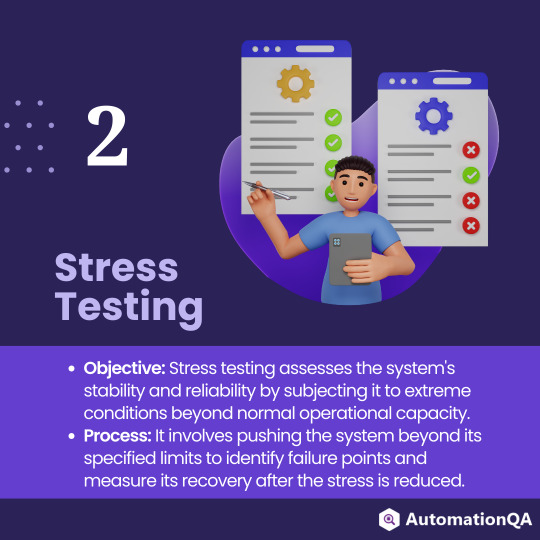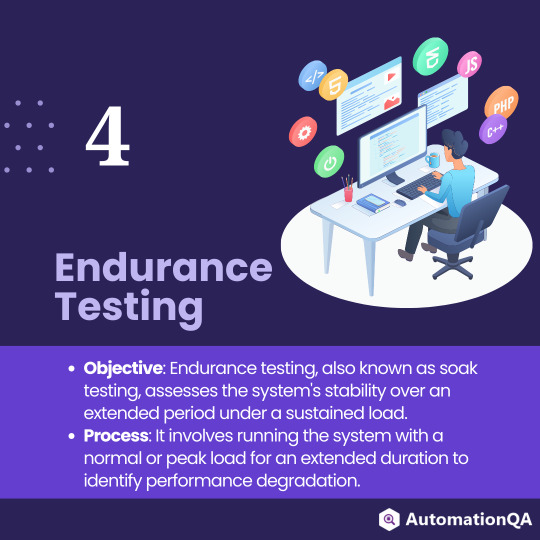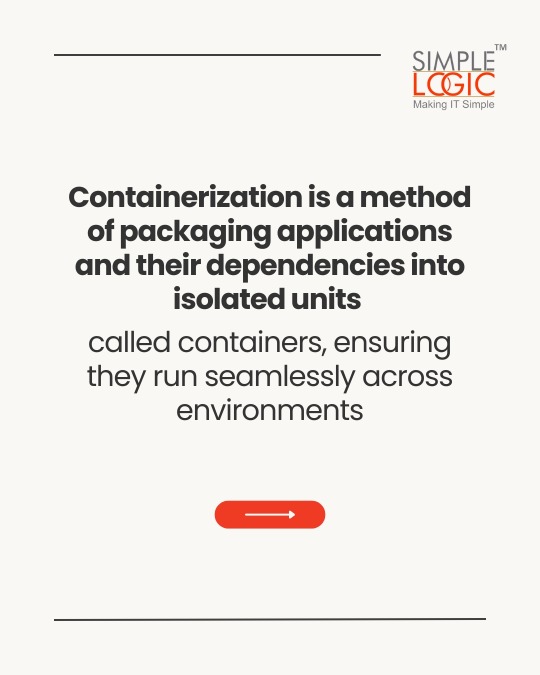#Scalability Testing
Explore tagged Tumblr posts
Text
Scalability Testing: Ensuring Future Growth
Scalability testing evaluates a system's ability to handle increasing workloads. In today's dynamic digital landscape, applications must accommodate growing user bases and data volumes. Scalability testing ensures that a system can perform efficiently under heavy load without degradation in performance.
There are two primary types of scalability: vertical and horizontal. Vertical scalability involves upgrading hardware resources, like CPU and RAM, on a single server. Horizontal scalability, on the other hand, involves adding more servers to distribute the load.
Scalability testing involves simulating real-world scenarios, such as peak traffic periods, data surges, and user spikes. Tools like JMeter, LoadRunner, and Gatling help simulate these scenarios, providing insights into system performance under stress.
Key metrics monitored during scalability testing include response time, throughput, resource utilization (CPU, memory, disk), and error rates. The goal is to identify bottlenecks and optimize the system to handle future growth.
Effective scalability testing is crucial for businesses aiming to expand their services. It ensures that the system can handle increased demand without compromising user experience. By proactively addressing scalability concerns, organizations can maintain a competitive edge and ensure long-term success. https://bugasura.io/blog/scalability-testing-in-software-testing/
0 notes
Text
How Load Testing Enhances User Experience and Application Stability

User experience and application stability are crucial in today's digital world. Be it an e-commerce site in festival sale or a game with millions of concurrent players or a Saas to back global enterprises; all of them must be ready to bear the load and this is why load testing becomes a necessity!
Load testing is the process of experimenting on an application with a group of users, so that you could determine its behavior when it has large (or not so large) amount people using it. This would be useful to identify any possibly slow bottlenecks, ensure proper performance of applications and clean user experience. This blog talks about load testing, helping to improve the user experience, ensuring the stability of the application and the necessity of load testing in contemporary applications.
What is Load Testing?
Load testing means testing an application with a specified number of users and measuring that performance. Teams can now look at response times, throughput and resource utilization under different conditions to predict the application parameters so that during high load the app behaves as intended.
Before the end-users face it, this way of proactive testing helps in finding the performance problems like slow load times or crash or server overload.
The Role of Load Testing in Enhancing User Experience
Faster Load Times
Users have a high expectation of how fast applications load, and any delays in that process often result in frustration or abandonment.
Load testing helps reveal slow-loading elements so that developers can optimize code and server configurations and result in faster response time.
Consistent Performance Across Devices
Make sure applications work well on various devices and platforms.
Load testing which virtually loads various devices are kept ensuring the homogeneity of all users.
Seamless Navigation During Peak Traffic
Servers may have to work extra hard, scenarios like flash sales or the launch of a product often lead to high traffic.
Load testing is done to ensure these types of applications can be prepared for these types of scenarios beforehand and tackle spikes without a slow-down.
Increased Customer Satisfaction
A non-crashing responsive application is a good user experience.
By identifying and addressing performance issues before they impact customers, load testing increases retention rates and creates brand loyalty.
How Load Testing Boosts Application Stability
Prevents Downtime
Unexpected traffic surges can cause servers to crash, resulting in downtime.
Load testing is to simulate the above scenario and to help identify the weak points and strengthen the server at capacity.
Detects Memory Leaks and Resource Bottlenecks
Memory leaks or high CPU usage under load could affect resource-intensive applications.
Load testing allows teams to pinpoint and resolve such problems before they become critical.
Ensures Scalability
Applications now must scale and that means increasing user numbers.
Load testing keeps an eye on the ability of an application to take on the load that the real world represents without losing efficiency or stability.
Validates Infrastructure Readiness
Simulated loads are the best way to test the infrastructure to make sure the backend works in real time.
Load testing includes testing on databases, APIs, and server configurations.
Improves Disaster Recovery Readiness
Load testing helps prepare teams for real-world failures by testing how an application recovers after a crash or an overload.
Best Practices for Load Testing
Define Clear Objectives
Identify your application’s performance goals before you begin. Defining how fast a response can be on a certain load and throughput level is one way to set deterministic guidelines.
Simulate Realistic User Behavior
Tools such as JMeter allow you to simulate actual customer actions (navigating, searching, buying, etc.). This ensures that the insights are correct.
Test in Stages
Conduct tests from normal user loads and scale up to peak loads will allow us to find patterns of degradation.
Use Cloud-Based Load Testing
Cloud resources enable testing in various geographical locations that present a true perspective on how well your application performs around the world.
Leverage Automation
Time is one of the many advantages of automated load testing tools, and they also allow for consistent testing due to the load generation code being the same.
The GhostQA Advantage in Load Testing
The GhostQA Load Testing Engine is based on JMeter. It gives an easier solution for performance testing. So here is what makes GhostQA different:
Low Code Testing Approach: Generate complex load tests with writing low code scripts, accessible to QA teams of any experience level.
Auto-Healing Features: With GhostQA, it adjusts to the changes in the application, which in turn reduces test maintenance efforts.
Comprehensive Reporting: In-depth test reports offer insights to optimize application performance.
Scalability: With minimal effort, you can simulate realistic loads and can test your application for stability.
GhostQA enables teams to include load testing right into their QA process for quality software that actually holds up in the real world.
Real-Life Applications of Load Testing
E-commerce Platforms: Prepare the website for events featuring high traffic such as seasonal sales or other promotions.
Gaming Applications: Validate your app is not only up but also do not crash under high usage workloads like a game release.
Streaming Services: Testing the quality of the stream under user load.
SaaS Applications: Ensure consistent performance to end users around the globe.
Banking Applications: Make sure that it is available even with high transactional load like days when the payroll is processed.
Conclusion
Load testing is key to delivering the high-quality software your customers expect. This stimulates the real factors that prevent the system from being unreal, and its agencies help to identify bottlenecks that improve operation and application stability.
GhostQA is a Performance testing automation tool that is AI based for load testing for the codeless platform. Solutions like GhostQA empower organizations to make sure that their applications are resilient, scalable, and ready to face the real-world load.
Begin Load Testing right from now to deliver an excellent user experience by stabilizing the application. Your users will be grateful for that!
#Load testing#Load Testing tools#Test automation#Scalability Testing#Cloud-Based Load Testing#User Experience#software#software testing#quality assurance#functional testing#automated testing
0 notes
Text





Elevate your software's performance game with these 4 essential testing types! 🚀✨
From Load to Stress, discover the key strategies to ensure your application thrives under any conditions.
#performance testing#testing#types#strategy#load testing#stress testing#scalability testing#endurance testing#application
0 notes
Text
Unveiling the Essence of Mobile App Performance Testing: Ensuring a Seamless User Experience

In the dynamic world of mobile applications, user experience is paramount. Users today demand fast, responsive, and glitch-free applications, making Mobile App Performance Testing an indispensable phase in the development life cycle. In this blog, we explore the significance of mobile app performance testing, its key components, and best practices to ensure your app stands out in the competitive mobile landscape.
Introduction: The Need for Speed
Mobile app users are notoriously impatient. A sluggish app can lead to user frustration, negative reviews, and, ultimately, abandonment. Mobile App Performance Testing is the proactive approach to identify and eliminate bottlenecks, ensuring your app not only meets but exceeds user expectations.
Why Mobile App Performance Testing Matters:
1.Optimal User Experience:
Performance testing helps ensure that your mobile app responds promptly to user interactions, creating a smooth and enjoyable user experience.
2. App Stability:
Identifying and addressing performance issues in advance ensures your app remains stable under various conditions, reducing crashes and unexpected behavior.
3.Customer Retention:
Users are more likely to stay loyal to apps that consistently perform well. Performance testing aids in retaining users and building a positive reputation.
4. Competitive Edge:
Outperforming competitors in terms of speed and reliability can set your app apart in a crowded marketplace.
Key Components of Mobile App Performance Testing:
1. Load Testing:
Assess the app’s performance under expected and peak loads to ensure it can handle user traffic without performance degradation.
2. Stress Testing:
Push the app beyond its limits to identify breaking points and weaknesses under extreme conditions.
3. Response Time Testing:
Measure the time it takes for the app to respond to user actions, ensuring swift and seamless interactions.
4.Memory and CPU Usage Testing:
Monitor and optimize memory and CPU usage to prevent resource exhaustion that can lead to slowdowns and crashes.
Best Practices for Effective Mobile App Performance Testing:
1. Start Early:
Incorporate performance testing from the early stages of development to catch and address issues before they escalate.
2. Test on Real Devices:
Emulators are useful, but testing on real devices is crucial to simulate real-world scenarios accurately.
3. Continuous Testing:
Implement continuous performance testing throughout the development life cycle to catch regressions and ensure ongoing optimization.
4. Monitoring in Production:
Utilize monitoring tools to keep track of the app’s performance in real-world scenarios post-launch, enabling quick responses to emerging issues.
Conclusion: Delivering Excellence in Performance
In the competitive realm of mobile applications, performance can be the differentiator between success and obscurity. Mobile App Performance Testing is not just a quality assurance checkpoint; it’s a commitment to delivering an exceptional user experience. By embracing performance testing as an integral part of your development process, you ensure that your mobile app not only meets but exceeds user expectations, securing its place in the hearts and devices of users worldwide.
Click the link below to learn more about the blog Mobile App Performance Testing:
#Mobile App Performance Testing#Mobile App Testing Best Practices#Ensuring Mobile App Scalability#Automated Performance Testing for Apps#Tudip Technologies#Tudip
1 note
·
View note
Text






#TechKnowledge Have you heard of Containerization?
Swipe to discover what it is and how it can impact your digital security! 🚀
👉 Stay tuned for more simple and insightful tech tips by following us.
🌐 Learn more: https://simplelogic-it.com/
💻 Explore the latest in #technology on our Blog Page: https://simplelogic-it.com/blogs/
✨ Looking for your next career opportunity? Check out our #Careers page for exciting roles: https://simplelogic-it.com/careers/
#techterms#technologyterms#techcommunity#simplelogicit#makingitsimple#techinsight#techtalk#containerization#application#development#testing#deployment#devops#docker#kubernets#openshift#scalability#security#knowledgeIispower#makeitsimple#simplelogic#didyouknow
0 notes
Text
Efficient Web Application Management with Modular Designs
When designing with modularity in web application development the sole main focus is enhancing efficiency, scalability, and maintainability . This actually possible by breaking down an application into independent, reusable modules. In contrast to a monolithic approach, where all components are tightly coupled, modular architectural design structures the application into separate, self-contained units. In such case, you can modularize the account verification, product management, and payment processing.
This separation allows web developers to work on individual modules without disrupting the entire system, making updates, debugging, and feature additions more manageable. Just like by following Laravel’s modular principles using Service Providers, Repositories, and Packages, teams can develop cleaner, more structured codebases that are easier to scale and maintain.
Support Parallel Development and Flexibility
Modular architecture enables software development teams to build, test, and deploy individual features independently. If one module requires changes or optimizations, it can be modified without affecting the rest of the application, reducing downtime and improving development speed. So, the modular architecture is particularly beneficial for large-scale applications like an office furniture online system, where different teams may handle inventory, customer management, and order processing as separate modules. Try implementing modularization with Laravel, you'll achieve a robust, high-performing, and future-proof web application that efficiently adapts to growing demands.
#modular#architecture#modular architecture#laravel modular architecture#modular design#office furniture#online office furniture system#high performance#laravel modules#laravel framework#PHP framework#web application design#monolithic#parallel development#large scale applications#service providers#flexibility#maintainable application design#scalable application design#coupling#cohesion#reusable patterns#software patterns#software testing#web deevlopment
0 notes
Text
Leverage the power of Flutter to create stunning, high-performance mobile applications with Quokka Labs. Our Flutter app development services provide scalable, cross-platform solutions for both iOS and Android, ensuring seamless functionality and an engaging user experience. Whether you're building a new app or enhancing an existing one, our team delivers Flutter mobile app development that accelerates time-to-market and reduces costs without compromising quality.
#Flutter app development services#Flutter mobile app development#Cross-platform app development#Flutter developers#Custom Flutter app solutions#iOS and Android Flutter apps#Mobile app development with Flutter#Scalable Flutter apps#Flutter app testing and deployment#Fast Flutter app development
0 notes
Text
Choosing the right cloud disaster recovery solution requires careful consideration of factors like Recovery Point Objectives (RPO), Recovery Time Objectives (RTO), data security, scalability, cost, and vendor reliability. Implementing best practices can minimize downtime and data loss, ensuring that businesses remain resilient during disasters.
#cloud disaster recovery#cloud DR solution#business continuity#disaster recovery plan#RPO#RTO#data security#scalable recovery#cloud DR vendors#disaster recovery testing#geographic redundancy
0 notes
Text
"A German bio-tech company has developed a naturally-occurring enzyme discovered in a cemetery into a near-market ready solution for recycling plastic without any loss of quality.
In 2022, GNN reported on a paper published by Leipzig-based scientists who first identified the enzyme. At the time, the enzyme was subject to a small side-by-side test, and caused the polyethylene terephthalate (PET) plastic to decompose by a whopping 90%.

Pictured: Before and After: A container of PET after 24 hours of contact with the enzyme leaves only dye
Fast forward to the spring of 2025 and those same scientists have perfected the capabilities of that enzyme, called PHL7, and have founded ESTER Biotech to bring those capabilities to market.
Their initial plan to be finished next year is a bathtub-sized pilot project reactor. If successful, their 2030 plan will be four 350 cubic-meter reactors capable of processing 45,000 metric tons of PET plastic every year.
PHL7 and ESTER Biotech boast several advantages over chemical and thermal recycling methods. For starters, once the polymers of PET are broken by the enzyme into monomers, or single component parts, they have suffered no degradation of their material characteristics unlike some recycled plastic which is weaker or less stable.
Additionally, PHL7 is exceptionally stable from 32 to 203 degrees Fahrenheit (0-95°C), and per kilogram of plastic, a dose of only 0.02% to 0.06% of the enzyme is required—substantially less than existing alternatives. Their new version of the enzyme also recycles the plastic several hours faster.
“Our technology makes it possible to bring material flows that are currently burned back to the beginning of the cycle at the molecular level,” says Christian Sonnendecker, lead author on the paper of the enzyme’s discovery, and co-founder of ESTER Biotech at the University of Leipzig. “And with high energy efficiency and scalability.”
“We are only at the beginning. But we are convinced that when science, entrepreneurial spirit and social responsibility come together, a cemetery enzyme can become a beacon of hope for a better future.”
RECYCLING BREAKTHROUGHS:
Scientists in Japan Develop Non-Toxic Plastic That Dissolves in Seawater Within Hours
Cornell Researchers Create First-of-its-Kind Durable and Recyclable Plastic
New Process ‘Vaporizes’ Plastic Bags and Bottles to Help Make Recycled Materials
Revolutionary New ��Living Plastic’ That Could Slash Damage to the Environment Developed by California Researchers
ESTER Biotech’s enzyme is able to separate certain multilayer composites which are normally thought of as unrecyclable. In addition to the infrastructure of the pilot project, ESTER is currently working with two medium-sized partners to build a cost-efficient supply chain with an aim to reduce the enzyme price to between 100 and 200 euros per kilogram.
Though no currently-commercialized recycling method can compete with the cost of virgin plastic, a price between 100 and 200 euros will put it in line with existing competitors.
Fortunately for anyone in the space, the EU is not afraid to use heavy-handed regulation to guarantee plastic recycling rates. By 2040, under existing EU legislation, 65% of plastic production will be mandated to come from recycled sources. ESTER believes that with its potential to offer a higher quality “recyclate,” the incentive to pursue and expand enzymatic methods will increase."
-via Good News Network, June 13, 2025
#recycling#plastic#plastic pollution#environmental science#enzyme#waste#waste management#plastic recycling#germany#eu#europe#good news#hope
2K notes
·
View notes
Text
Also preserved on our archive (Thousands of reports, sources, and resources! Daily updates!)
By Robert Stevens
A COVID wave fuelled by the XEC variant is leading to hospitalisations throughout Britain.
According to the UK Health Security Agency (UKHSA), the admission rate for patients testing positive for XEC stood at 4.5 per 100,000 people in the week to October 6—up significantly from 3.7 a week earlier. UKHSA described the spread as “alarming”.
Last week, Dr. Jamie Lopez Bernal, consultant epidemiologist at the UKHSA, noted of the spread of the new variant in Britain: “Our surveillance shows that where Covid cases are sequenced, around one in 10 are the ‘XEC’ lineage.”
The XEC variant, a combination of the KS.1.1 and KP.3.3 variants, was detected and recorded in Germany in June and has been found in at least 29 countries—including in at least 13 European nations and the 24 states within United States. According to a New Scientist article published last month, “The earliest cases of the variant occurred in Italy in May. However, these samples weren’t uploaded to an international database that tracks SARS-CoV-2 variants, called the Global Initiative on Sharing All Influenza Data (GISAID), until September.”
The number of confirmed cases of XEC internationally exceeds 600 according to GISAID. This is likely an underestimation. Bhanu Bhatnagar at the World Health Organization Regional Office for Europe noted that “not all countries consistently report data to GISAID, so the XEC variant is likely to be present in more countries”.
Another source, containing data up to September 28—the Outbreak.info genomic reports: scalable and dynamic surveillance of SARS-CoV-2 variants and mutations—reports that there have been 1,115 XEC cases detected worldwide.
Within Europe, XEC was initially most widespread in France, accounting for around 21 percent of confirmed COVID samples. In Germany, it accounted for 15 percent of samples and 8 percent of sequenced samples, according to an assessment from Professor Francois Balloux at the University College London, cited in the New Scientist.
Within weeks of those comments the spread of XEC has been rapid. Just in Germany, it currently accounts for 43 percent of infections and is therefore predominant. Virologists estimate that XEC has around twice the growth advantage of KP.3.1.1 and will be the dominant variant in winter.
A number of articles have cited the comments made to the LA Times by Eric Topol, the Director of the Scripps Research Translational Institute in California. Topol warns that XEC is “just getting started”, “and that’s going to take many weeks, a couple months, before it really takes hold and starts to cause a wave. XEC is definitely taking charge. That does appear to be the next variant.”
A report in the Independent published Tuesday noted of the make-up of XEC, and its two parent subvariants: “KS.1.1 is a type of what’s commonly called a FLiRT variant. It is characterised by mutations in the building block molecules phenylalanine (F) altered to leucine (L), and arginine (R) to threonine (T) on the spike protein that the virus uses to attach to human cells.
“The second omicron subvariant KP.3.3 belongs to the category FLuQE where the amino acid glutamine (Q) is mutated to glutamic acid (E) on the spike protein, making its binding to human cells more effective.”
Covid cases are on the rise across the UK, with recent data from the UK Health Security Agency (UKHSA) indicating a 21.6 percent increase in cases in England within a week.
There is no doubt that the spread of XEC virus contributed to an increase in COVID cases and deaths in Britain. In the week to September 25, there were 2,797 reported cases—an increase of 530 from the previous week. In the week to September 20 there was a 50 percent increase in COVID-related deaths in England, with 134 fatalities reported.
According to the latest data, the North East of England is witnessing the highest rate of people being hospitalised, with 8.12 people per 100,000 requiring treatment.
Virologist Dr. Stephen Griffin of the University of Leeds has been an active communicator of the science and statistics of the virus on various public platforms and social media since the start of the pandemic. He was active in various UK government committees during the height of the COVID-19. In March 2022, he gave an interview to the World Socialist Web Site.
This week Griffin spoke to the i newspaper on the continuing danger of allowing the untrammelled spread of XEC and COVID in general. “The problem with COVID is that it evolves so quickly,” he said.
He warned, “We can either increase our immunity by making better vaccines or increasing our vaccine coverage, or we can slow the virus down with interventions, such as improving indoor air quality. But we’re not doing those things.”
“Its evolutionary rate is something like three or four times faster than that of the fastest seasonal flu. So you’ve got this constant change in the virus, which accelerates the number of susceptible people.
“It’s creating its own new pool of susceptibles every time it changes to something that’s ‘immune evasive’. Every one of these subvariants is distinct enough that a whole swathe of people are no longer immune to it and it can infect them. That’s why you see this constant undulatory pattern which doesn’t look seasonal at all.”
There are no mitigations in place in Britain, as is the case internationally, to stop the spread of this virus. Advice for those with COVID symptoms is to stay at home and limit contact with others for just five days. The National Health Service advises, “You can go back to your normal activities when you feel better or do not have a high temperature”, despite the fact that the person may well still be infectious. Families are advised that children with symptoms such as a runny nose, sore throat, or mild cough can still “go to school or childcare' if they feel well enough.
The detection and rapid spread of new variants disproves the lies of governments that the pandemic is long over and COVID-19 should be treated no differently to influenza.
Deaths due to COVID in the UK rose above 244,000 by the end of September. It is only a matter of time before an even deadlier variant emerges. Last month, Sir Chris Whitty, England’s chief medical officer, told the ongoing public inquiry into COVID-19 “We have to assume a future pandemic on this scale [the global pandemic which began in 2020] will occur… That’s a certainty.”
#mask up#covid#pandemic#wear a mask#public health#covid 19#wear a respirator#still coviding#coronavirus#sars cov 2
145 notes
·
View notes
Text
Breakthrough
Request: Yes / No
Don’t be shy, request things! <3 Have a nice day/night
Jughead Jones x Fem!Reader
Word count: 588
Warnings: Nothing I think
PLEASE DO NOT STEAL MY WORK, I WORK HARD ON MY FICS AND IT’S NOT COOL TO STEAL SOMEONE ELSE’S WORK!
If you want to be on the tag list for anything (My series fics, specific character fics, or just all of them) All you have to do is send me an ask and I will add you!
Masterlist
If you enjoy my work, you could also show support by buying me a coffee!
(Not my photo, credit to whoever made it!)

The light of the Blue and Gold office flickered slightly as I burst through the door, papers clutched tightly in my hands and excitement buzzing through my veins like electricity. Jughead was sitting at his desk, his beanie pushed back slightly as he stared at his laptop screen, probably lost in whatever investigative piece he was working on.
“Do you know what this means!?” I practically shouted, slamming my papers onto the desk before him. Jughead didn’t even flinch, his dark eyes lifting from the screen to meet mine with an amused and tired look.
“It means you haven’t slept in seventy-two hours?” He deadpanned, leaning back in his chair and folding his arms. I groaned, rolling my eyes.
“No! Well…maybe, but that’s not the point!” I jabbed at the papers with my finger.
“This is it, Juggie! This is the breakthrough I’ve been working towards for months! Do you even realize what I’ve done?” He raised an eyebrow, a small smirk tugging at the corners of his lips.
“I’m guessing it’s more important than sleep?”
“Way more important!” I exclaimed, ignoring the fact that he was probably right. My hands practically shook as I shuffled through the papers, pointing out the key calculations, notes, and graphs.
“This could change everything! This proves that the molecular bonds… okay, wait, you don’t care about the science, but trust me, it’s huge!” Jughead tilted his head, his smirk softening into a genuine smile as he watched me.
“I care. Maybe not about the technical stuff, but I care because it’s you, and apparently, it’s huge.” I paused, my heart swelling a little at his words. Jughead wasn’t always the most expressive person, but moments like this reminded me why I adored him.
“You don’t get it!” I said, trying to contain my excitement long enough to explain.
“This could revolutionize energy storage. I’m talking about a clean, scalable source of energy that’s efficient, affordable, and scalable. Do you know what this could mean for the environment? For the future?” His eyes lit up then, a flicker of understanding mingled with pride.
“Wow…” He said softly, his voice laced with awe.
“You’re changing the world.” I felt my cheeks flush, a mixture of pride and humility at his words.
“Well, I wouldn’t go that far yet. There’s still so much testing to be done and I’ll probably have to defend the findings against a hundred skeptics, but-”
“But you did this.” He interrupted, reaching out to place his hand over mine, stopping my frantic movement.
“You. You’ve been working nonstop, pouring everything you have into this, and now you’ve done it. That’s incredible!” The sincerity in his voice made my throat tighten, and I blinked back the sudden sting of tears.
“Thanks, Juggie, that means a lot.” He shrugged, his hand lingering on mine.
“It’s true. You’re amazing, you know that?” I laughed softly, shaking my head.
“I’m just a nerd with a lot of coffee and very little self-preservation.”
“Yeah, well” His smirk returned.
“You’re my nerd with a lot of coffee and very little self-preservation, and I’m proud of you.” I smiled at him, the weight of exhaustion momentarily lifting as I took in the warmth in his gaze.
“You’re pretty amazing you’re, ya know.” He chuckled, leaning forward to rest his chin on his hand.
“Tell me more about this world-changing breakthrough, but, uh, maybe in words a non-genius can understand?” I grinned, my excitement bubbling up again as I launched into a simplified version of my discovery.
Tag list: @les-bio-lie @tashy-bear @ashwarren32 @hollie-blogs-blog1 @lover-of-books-and-tea @nerdygaloresposts @teenwolfbitches28 @kmc1989 @drw0301bieber @lady-of-lies @ravenmoore14 @ravenempress101 @cillianchamp @rowanthomasknapp @rachelxwayne @ready-4-fanfiction @madammarvellous-blog1 @emo-godess-loves-you @hiya-imthatgirl @mindsetjupiter @averysinclaire @mittelerde1999 @sweetest-peas @rousewriter @camiconfessions-blog @thecaptainsgingersnap @cenyddtheunicorn @jacksxsouthsideserpents @lover2448 @mamacobie13 @rainbow-noodles @lovelywordsblog @darkestbeforethedawn16 @fandom-princess-forevermore @liz-owl
#fanfic#riverdale#riverdale imagine#jughead jones#jughead jones imagine#jughead jones x reader#jughead jones x fem!reader#jughead x reader#jughead x fem!reader
63 notes
·
View notes
Text
A bioreactor that mimics a circulatory system can deliver nutrients and oxygen to artificial tissue, enabling the production of over 10 grams of chicken muscle for cultured meat applications. These results are publishing in the Cell Press journal Trends in Biotechnology on April 16. "Our study presents a scalable, top-down strategy for producing whole-cut cultured meat using a perfusable hollow fiber bioreactor," says senior author Shoji Takeuchi of The University of Tokyo. "This system enables cell distribution, alignment, contractility, and improved food-related properties. It offers a practical alternative to vascular-based methods and may impact not only food production but also regenerative medicine, drug testing, and biohybrid robotics."
Read more.
22 notes
·
View notes
Text
youtube
Meet MBARI: This team develops innovative new technology to map the seafloor 🤖🗺️
With marine life and ecosystems facing a rising tide of threats, the ocean exploration community needs nimble, cost-effective tools for measuring and monitoring ocean health. MBARI’s Control, Modeling, and Perception of Autonomous Systems Laboratory, known as the CoMPAS Lab is up to the challenge.
MBARI scientists and engineers build and adapt advanced technology that enhances ocean data collection. Led by engineer Giancarlo Troni, the CoMPAS Lab team develops scalable marine technology that can easily be modified for use in a wide variety of vehicles and platforms.

Working with other teams across MBARI, the CoMPAS Lab leverages vehicles like the MiniROV to deploy and test new tools in Monterey Bay's submarine canyon and then adapt them for other mobile platforms. By sharing open-source design specifications and advanced algorithms with the wider ocean exploration community, we hope to expand access to MBARI’s engineering innovations.
MBARI technology is transforming what we know about the ocean and its inhabitants. Our scientists, engineers, and marine operations staff work together to create innovative tools for a more sustainable future where autonomous robots and artificial intelligence can track ocean health in real time and help us visualize ocean animals and environments. Studying our blue backyard is revealing our connection to the ocean—how it sustains us and how our actions on land may be threatening its future.

We’re spotlighting various teams at MBARI to showcase the different ways we’re studying the largest environment on Earth. We hope this series inspires a new generation of ocean explorers. Dive in.
39 notes
·
View notes
Text
How much of a $450 (£339) pot would you give to a charity that cuts carbon emissions by investing in renewable energy, and how much would you keep for yourself? That was the question posed in a recent academic experiment. The answers mattered: real money was handed out as a result to some randomly chosen participants.
The average person gave away about half the money and kept the rest. But what if you had been told beforehand that the vast majority of other people think climate action is really important? Might you have given more to the charity?
That is what a second experiment tested. Before dividing the cash, these participants were told that 79% of people thought citizens should try to fight the climate crisis. This mattered, because in earlier questions people had significantly underestimated the proportion at just 61%. Being informed about the true level of support boosted the donations by $16 for each person.
The experiment was in the US, but the illusion that climate action is not popular is global. So imagine dispelling that myth: such a shift, experts say, could be a gamechanger, pushing the world over a social tipping point into unstoppable climate progress.
Such a communication campaign, low-cost and scalable, could be among the most powerful tools available to fight the climate crisis, they say. Decades of psychological research indicates that correcting such misunderstandings can change people’s views across a swathe of issues, from participating in protests to voting for Donald Trump.
“We’re sitting on an enormous potential climate movement,” said Prof Anthony Leiserowitz, at Yale University in the US. “It’s latent. It hasn’t been activated or catalysed. But when you break through these perception gaps, you help people understand that they’re not alone and there is in fact a global movement.”
The research started with a simple goal, says Prof Teodora Boneva, at the University of Bonn, Germany, who with colleagues undertook the experiments: “We wanted to make a difference to the world. So we asked ourselves, as social scientists and economists: what kind of research can we do?”
Their biggest result was a huge, globe-spanning survey that revealed the remarkable fact that people across the world are united in wanting action to fight the climate crisis but remain a silent majority, because they wrongly think only a minority share their views.
“Before, just like everyone else, we would have underestimated the support,” she says. “So when we saw the numbers coming in, we thought: ‘Wow!’ We had no idea we would find such consistent patterns in so many countries.”
The team found 89% of people across the world wanted their national governments to do more to fight global heating. More than two-thirds said they were willing to give 1% of their income to fight the climate crisis. Crucially, however, they thought only a minority of other people – 43% – would be willing to do the same.
The survey involved 130,000 people in 125 countries, which account for 96% of the world’s carbon emissions, and was published in the journal Nature Climate Change. People in China, the world’s biggest polluter, were among the most concerned, with 97% saying its government should do more to fight the climate crisis and four out of five willing to give 1% of their income. The world’s second biggest polluter, the US, was near the bottom, but still had three-quarters of its citizens saying its government should do more and almost half willing to contribute.
Even in the petrostates of Saudi Arabia and the United Arab Emirates, the vast majority – about 80% – were willing to give 1% of their income to climate action. How many of these wanted more government action is unknown: these countries did not allow the question to be asked.
Those feeling the heat most directly had the strongest pro-climate views. Those in rich countries were significantly less willing to contribute 1%. And the countries where people most strongly wanted to fight the climate crisis had implemented significantly more climate policies, the researchers found. The more strongly people believed their fellow citizens would contribute their money to climate action, the more likely they were to give themselves, as Boneva’s experiments with the $450 pots showed.
“These positive interactions suggest that a change in one factor can unlock potent, self-reinforcing feedback cycles, triggering social-tipping dynamics,” the team concluded. “Our results suggest a concerted effort to correct these misperceptions could be a powerful intervention, yielding large, positive effects.”
A single survey, such as that by Boneva and colleagues, is fascinating – but perhaps you are thinking it could be a freak result. It is not. Many large studies have shown that the public desire for climate action is deep and global, and that the misperceptions that fuel a “spiral of silence” on climate are found wherever researchers look.
A UN poll in 2024 – dubbed the People’s Climate Vote – questioned 75,000 people in countries representing 90% of the global population. It found 80% wanted their countries to strengthen their climate commitments. Another recent survey of 40,000 people in 20 of the world’s most polluting countries found that 86% of people thought the same.
How the question is phrased can change, but people’s hunger for climate action does not. A survey of 140,000 people (pdf) in 187 countries and territories by the Yale Program on Climate Change Communication asked how high a priority climate change should be for the government of their country: 89% of people said very high, high or medium, with 67% saying very high or high.
The perception gaps are real too. A US study from 2022 found people thought only about 40% of their fellow citizens supported climate policies: the real proportion was about 75%. An earlier study found the same in China.
Other commonly held beliefs have been revealed as false, including the idea that people in rich nations are unwilling to give money to poorer nations to help fight the climate crisis. A study testing support for the redistribution of money from a global emissions trading scheme from the rich to the poor found the scheme was backed by 76% of Europeans and 54% of those in the US.
“There is also majority support for global redistribution policies, even among people in high-income countries who understand that they would have to pay for it,” said Fabre. “This is because people attach value to the human rights and wellbeing of fellow human beings and to a stable climate.”
But is this huge support for climate action in surveys actually sincere, or is it just people saying what they think the researchers want to hear?
Fabre, Boneva and other academics routinely test the reliability of information from surveys using numerous tools. These include comparing people’s answers with their real-world behaviour, for example, finding correlations between people’s stated willingness to pay money for climate action and their actual donations to climate charities.
Other tests link their answers to real-world consequences, such as telling them their answers would be sent to the government, or by hiding the climate questions among others so the respondents cannot guess the “right” answer.
In any case, Fabre said: “Polls are rarely wrong by more than 5%.” That can make a big difference in tight elections, but not when talking about large majorities such as the 89% wanting more climate action from their governments.
Do you think politicians suffer under the same illusions about the popularity of climate action as the public? You might think their political antennas are finely tuned to public opinion, but they are not – sometimes wildly underestimating public views. And that matters, said Dr Niall McLoughlin, at Climate Barometer, which analyses climate opinions in the UK.
The group found in 2024 that 72% of the UK public supported onshore wind being built in their areas, but only 19% of MPs thought a majority of their constituents did so. “That was a barrier to the approval and rollout of developments,” the analysts concluded. Similar results have been found in the US Congress on carbon regulations.
Climate action is backed even by those who vote for political parties that are explicitly opposed to it, according to the UK’s More in Common thinktank. The rightwing populist Reform UK party recently labelled climate concern “hysteria” but 62% of the people who voted for the party in 2024 said it was important that the government cares about tackling climate change.
Article continues in link
14 notes
·
View notes
Text
A team from the Lanzhou Institute of Chemical Physics at the Chinese Academy of Sciences devised a method of crushing and chemically treating old turbine blades so that they could be mixed into materials used in road construction.
This material was already trialed and has been in place on a section of Qingfu Highway in northwest China for over five months. So far, there have been no reports of cracking or rutting in this hybrid material, and it appears to be "long-lasting."
While most parts from old wind turbines can be recycled or reused, including the shell, nacelle, and metallic internal components, the long blades are typically made from fiberglass. That's especially true of blades that are reaching the end of their lifespan now, after having been in use for the last couple of decades.
This breakthrough joins a short list of applications – compiled by Chemical & Engineering News – where recycled blades can be useful:
Global Fiberglass Solutions, headquartered in Kirkland, Washington, turns the blades into reinforced plastic pellets for manufacturing durable products like maintenance hole covers.
Waste management giant Veolia shreds blades into small pieces that go in kilns to replace the coal, sand and clay required to make cement.
Knoxville, Tennessee's Carbon Rivers recovers strong fibers from blades using a high-temperature process called pyrolysis; these can be used as-is or in the form of thermoplastic fabrics or pellets to make heavy-duty automotive parts.
There are also a number of efforts to make blades easier to repurpose or discard – from a quick-dissolving resin to manufacture them, to GE's recyclable thermoplastic, to a relatively inexpensive way to break down epoxy-based blades.
But while those are being tested and deployed worldwide over the next few decades, we'll still have this mounting issue of disposed blades to solve. The Lanzhou research team, meanwhile, will take on more projects to demonstrate its recycling technique, and establish it as a scalable way to repurpose old blades.
MORE
#solarpunk#solarpunk business#solar punk#reculture#wind turbines#recycling#fibreglass#materials innovation
9 notes
·
View notes
Text
The Role of Relays and Timers in Industrial Automation Systems

In the world of industrial automation, efficiency, safety, and precision are crucial. Among the many components that contribute to a well-functioning automated system, relays and timers play a foundational role. These devices act as control elements that manage the flow of electricity, signal processes, and coordinate timing sequences — ensuring that operations run smoothly and safely.
In this article, we’ll explore how relays and timers work, their types, applications in automation systems, and how high-quality products — like those offered by Enza Electric — can enhance performance and reliability in industrial settings.
What Are Relays?
A relay is an electromechanical or electronic switch used to control a circuit by a separate low-power signal or multiple signals. In industrial automation, relays act as a bridge between the control system and the equipment being operated — allowing machines to be turned on or off automatically.
Types of Relays Commonly Used in Automation:
Electromechanical Relays (EMRs): Use physical moving parts; reliable and easy to maintain.
Solid-State Relays (SSRs): No moving parts; faster switching, longer lifespan, and better for high-speed applications.
Thermal Overload Relays: Protect motors and equipment from overheating.
Control Relays: Designed for controlling multiple contacts simultaneously in automation systems.
What Are Timers?
Timers are devices used to delay or repeat electrical signals at predetermined intervals. They help synchronize tasks, automate sequences, and provide controlled outputs over time — critical for complex industrial processes.
Common Timer Functions:
On-delay and off-delay timing
Interval timing
Cyclic or repeat cycle operation
Flashing and sequencing operations
Types of Timers:
Analog Timers: Manual dial settings, simple and cost-effective.
Digital Timers: Offer precise programming, displays, and flexible timing ranges.
Programmable Timers: Ideal for complex automation routines requiring multiple sequences.
Key Roles in Industrial Automation Systems
1. Process Control and Sequencing
Relays and timers enable automated machines to follow a specific sequence — turning motors, lights, or pumps on and off in a logical order. For example, a conveyor system can use a relay-timer combination to control material flow with millisecond precision.
2. Safety and Protection
Relays protect systems by interrupting circuits in case of faults. Combined with timers, they can ensure delay before activating emergency stop functions, preventing false triggers and increasing worker safety.
3. Load Management
In high-demand industrial environments, relays help manage load distribution by selectively energizing or de-energizing machinery. Timers assist in staggered starts, reducing power surges.
4. Energy Efficiency
By automating start/stop functions and managing operation durations, timers help reduce unnecessary energy use. Relays ensure only the necessary loads are powered, minimizing wastage.
5. System Monitoring and Feedback
In smart automation, relays provide feedback signals to the control system. Timers assist with diagnostics by creating intervals for testing or data collection.
Benefits of Using High-Quality Relays and Timers
Choosing the right components significantly impacts system performance and longevity. Enza Electric’s relays and timers are engineered with:
High durability for tough industrial environments
Precision timing for reliable operation
Easy installation and compact designs
Compliance with international safety and quality standards
By integrating Enza’s low-voltage solutions, businesses in the GCC, MENA, and Africa regions benefit from cost-effective, scalable automation that supports both current needs and future expansion.
Common Applications in Industrial Sectors
Manufacturing Plants: Control of motors, robotic arms, and production lines.
HVAC Systems: Timed control of fans, compressors, and dampers.
Water Treatment Facilities: Sequenced operation of pumps and valves.
Packaging Machinery: Relay and timer-based coordination of packing, sealing, and labeling.
Food and Beverage Industry: Process automation with hygiene-compliant controls.
Final Thoughts
Relays and timers are the silent operators behind the success of industrial automation systems. From process optimization to enhanced safety and energy management, these components are indispensable.
When sourced from a trusted manufacturer like Enza Electric, businesses are not only investing in reliable hardware but also in the longevity, scalability, and safety of their entire operation.
Ready to Power Your Automation?
Explore Enza Electric’s wide range of relays, timers, and other low-voltage switchgear solutions designed to meet the evolving demands of modern industries. Visit www.enzaelectric.com to learn more or request a quote today.
9 notes
·
View notes